by John Smelser
“Good planting skills are not abstract concepts to be learnt solely from books, catalogues and other people. The best way to start is by learning to look, and in looking to see and to see critically. Nothing costs us so dear as a waste of time, said Diogenes. But never think that moments spent walking round your garden are wasted time. In them the seed of inspiration may be sown, and without inspiration a garden may be pretty but lack beauty, interesting but not memorable, and disturbing rather than restful. Ideas take time to evolve and mature, and it is by sitting or walking silently that they can come flooding in.” Rosemary Verey
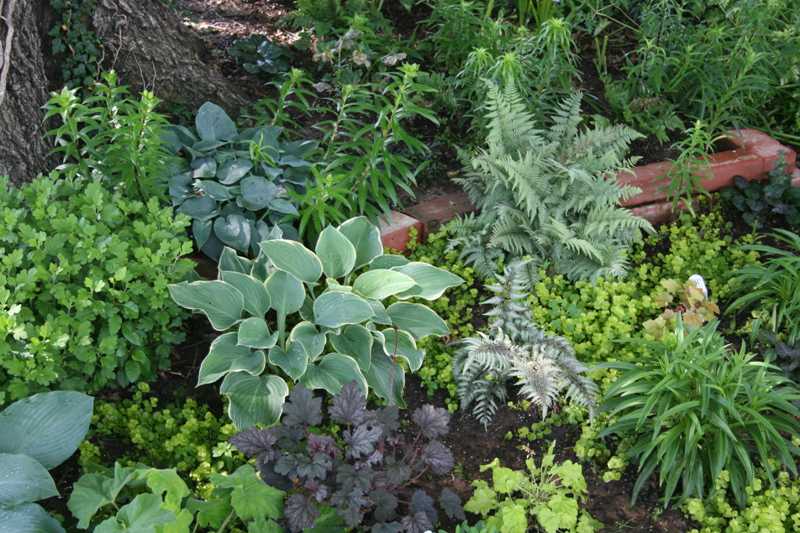
|
These perennials in the shade of a large tree illustrate a very good design principle for groupings of plants: a grouping of plants made with many different plants is more visually interesting than a grouping made with many of the same plant.
Different foliage colors and textures and the varying forms individual plants assume are each a richly varied element in a visual feast. A mixed planting is decidedly more interesting to look at… and a lot less trouble to maintain. And this approach can easily be accomplished with compact and dwarf cultivars in smaller gardens.
Mixed plantings offer you one additional advantage: if one of the plants dies, you can plant another matching one; or you can plant something else! Planting a row, or a grouping, of the same plant obligates you to replace a dead plant with the same plant. Take, for example, a hedge in which one plant in the middle dies. You are obligated to try and find another matching plant that will instantly fill the void. With a mixed planting, you are freed to consider alternatives. Mixed plantings help you avoid one of the more frustrating aspects of gardening… and free you to cultivate creativity when searching for a replacement. |
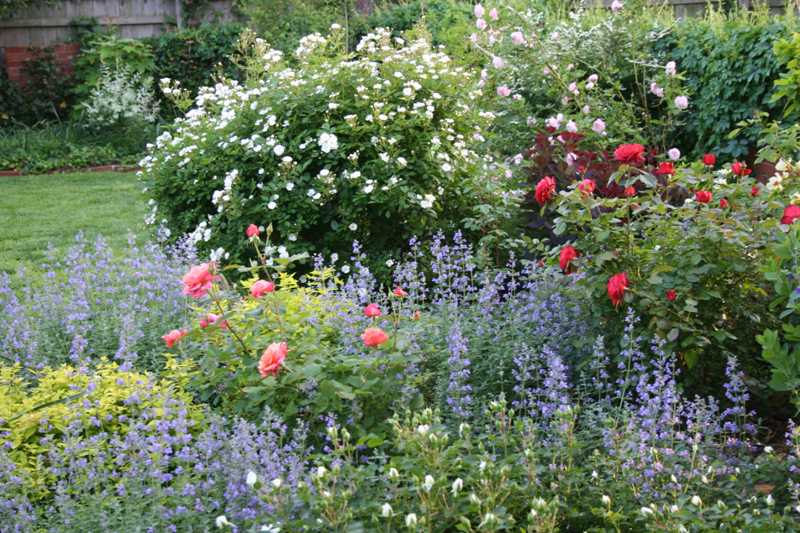
|
Roses are an exuberant addition to any garden- providing masses of striking blooms throughout the growing season. But in many cases they stand isolated and alone in garden beds, with no other plants beneath or near them.
An old English gardening book about Gertrude Jekyll told of her love for combining rose plantings with clumps of Faassen’s catmint, Nepeta faassenii. This image might help you realize why she favored the combination.
The catmint blooms for long periods, and reblooms in late summer if deadheaded after the first flush is spent. Best of all, gray-green foliage and the lavender-blue blooms blend beautifully with whatever color of rose you are growing. |
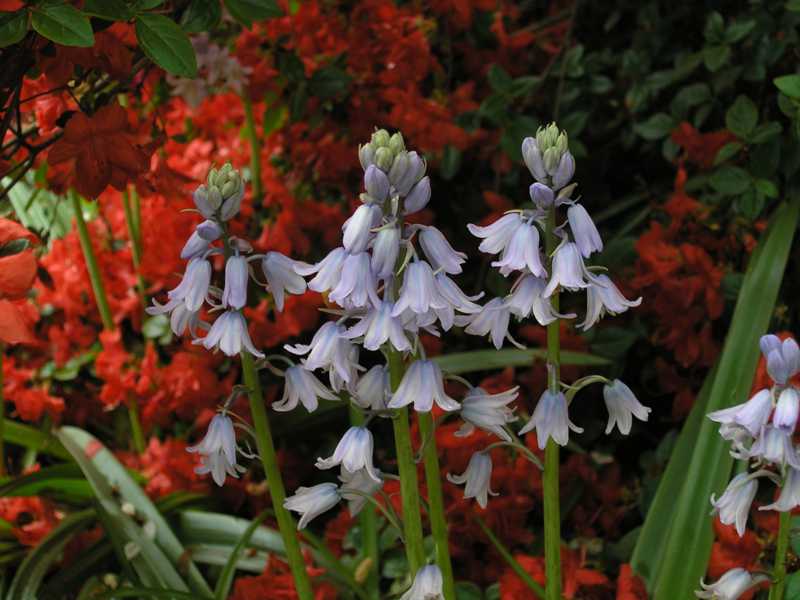
|
Bulbs are an invaluable addition to the garden in any season. Even better, bulbs are an extra dimension that can be added to any part of the garden that you do not constantly cultivate. In the spring they can illuminate portions of the garden in which perennials are just emerging. In summer they can provide color where spring flowering plants have exhausted their floral display.
One excellent rule of thumb: always consider the background plants when you are selecting and placing bulbs.
In this image, taken at MBG, Spanish bluebells, Hyacinthoides hispanica, were planted in front of a grouping of bright red azaleas to provide an eye-popping effect. The blue against the red is very dramatic. Careful plant selection is important here if you want both to flower at the same time. Check blooming times for the plants or cultivars you are considering. |
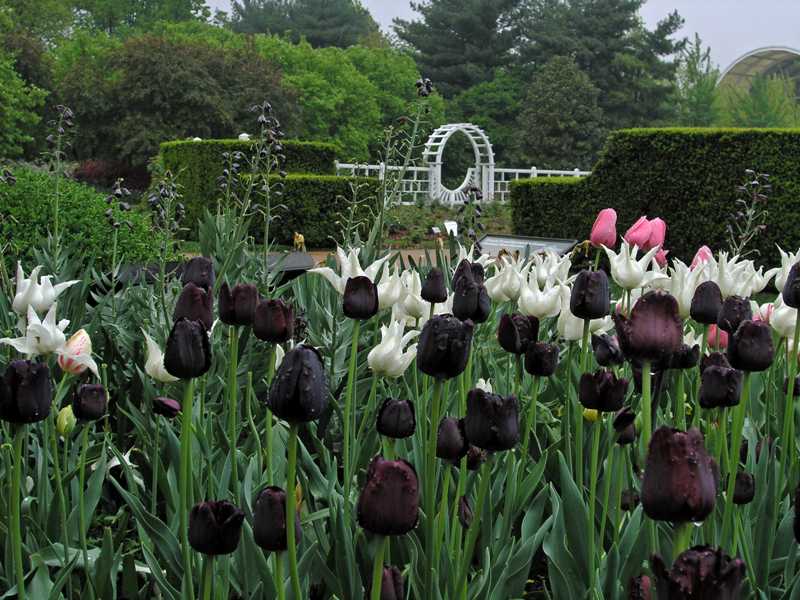
|
Bulbs don’t bloom for prolonged periods; many are in flower for as brief a period as one to two weeks. This should not deter you from using them to best advantage. Carefully chosen bulbs can have a lavish impact in your garden.
In this example, the flower spikes of Persian fritillaries, Fritillaria persica, made a fitting companion for these “black” and white tulips just outside the rose garden at MBG in 2004. Some might find this a somber floral display. But its significant departure from what is sometimes expected in a botanic garden made it striking and very appealing. A grouping like this would certainly stand out in any home garden and could be very effective if used carefully.
Take note of the fact that the primary background for this large grouping of tulips consisted of solid colored evergreens, allowing this bold flowering to take center-stage for a brief period in spring. |
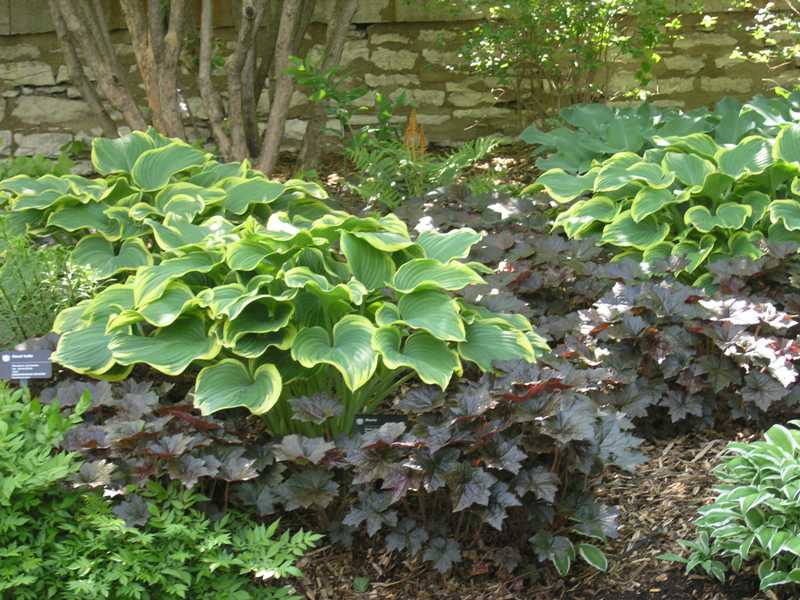
|
Many gardeners complain that they have trouble getting anything interesting to grow in the shade. Please don’t let this attitude become part of your garden philosophy. Shade plantings can be one of the jewels of your garden. hostas, heucheras, hellebores, geraniums, and lilies are just a few of the terrific foliage and flowering perennials that can brighten a shade garden. In this image the largest perennials are Hosta ‘Sagae.’ It is a particularly striking member of this very important genus of plants. The beautifully variegated foliage seems to float 2 feet above the ground on very upright stems. It looked elegant in the hosta border at MBG, in part because it was interplanted with ‘Palace Purple’ heuchera, Heuchera micrantha var. diversifolia 'Palace Purple'. Additional plantings that spring included lilies and hardy ferns. |
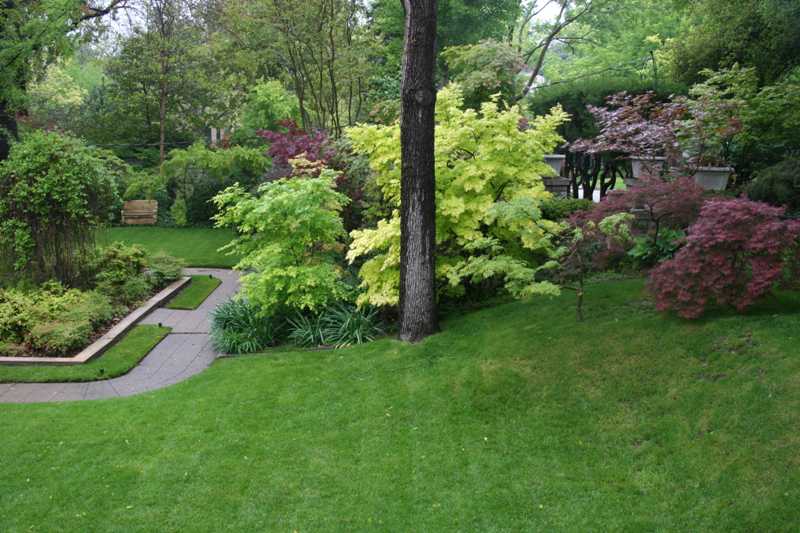
|
If shade in your garden is created by several large trees and expanses of lawn, you might decide beds of bulbs and perennials are not to your liking. In this case, you might want to consider understory trees and shrubs planted in the lawn. Chosen with an eye toward foliage form and color, this approach can be every bit as exciting as large beds of blooms.
In this example, seven varieties of Japanese maple, Acer palmatum, Acer palmatum var. dissectum, and Acer japonicum, were combined to create a sumptuous display throughout the growing season. Each small tree has different foliage shapes. Some have red foliage from spring to fall; some have varying shades of green. In fall, each acquires varying shades of yellow, orange, and red foliage. Winter silhouettes vary in shape from vase-like to spreading to weeping. |

|
In this image, the background planting of Japanese and paperbark maples, Acer palmatum and Acer griseum, is very nice but will only become prominent after the peony border has finished blooming. This combination of trees and blooms also illustrates a principle of Japanese gardening that is easily applied to western gardening. That principle can be succinctly described as “one thing at a time.” The deep and long border of mixed herbaceous peonies, Paeonia lactiflora, is a stand-alone image of beauty and elegance. If you plant peonies in your home garden, certainly consider planting them in groups. There is no doubt peonies are beautiful individually… but in groupings and drifts they create a magical and breathtaking picture.
Two aspects of growing peonies that should be given close attention:
[1] When planting bare-root stock make very sure the eyes are planted no more than 2 inches below the surface of the soil in cold climates. In warm climates plant the eyes 1.5 inches or a little less below ground level. I cannot emphasize too strongly not to plant the eyes too deep.
[2] Peony flowers are quite heavy and the flower will bend almost to the ground if the stems are not supported. Your nurseryman should be able to provide you with peony “cages” that do an excellent job of holding the stems and flowers upright. These cages are placed above the crown of newly emerging plant and can easily be stored in the garage or garden shed in winter. Well-made ones will last a lifetime. |

|
Small beds don’t have to be boring. They also do not have to be filled with annual flowers to be exciting. The bed in this image measures about 8 feet long and 2 feet deep. It demonstrates another good solid principle of planting design: foliage can be just as exciting as flowers, and it lasts a lot longer. Three varieties of ferns and a groundcover serve as underplantings for a cutleaf, weeping Japanese maple. In the foreground is Japanese tassel fern, Polystichum polyblepharum. In the middle a Japanese painted fern, Athyrium niponicum var. pictum grows out of a groundcover of bugleweed, Ajuga reptans ‘Catlin’s Giant’. The large background planting is Japanese shield fern, Dryopteris erythrosora. All of these plantings thrive in soil that has been enriched with peat moss to a depth of about 12 inches and is kept lightly moist. |
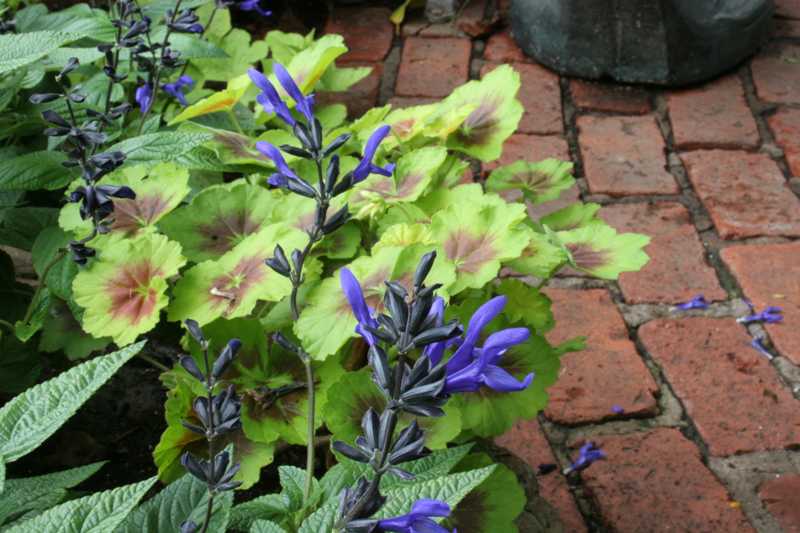
|
Annuals have a valuable place in any garden, and they can be particularly effective when mixed together in containers. ‘Black and Blue’ salvia, Salvia guaranitica ‘Black and Blue’ is a uniquely beautiful annual that can be effectively used in containers and in garden beds. Bright green foliage, “black” flower spikes and calyxes, and cobalt blue flowers mix beautifully with many other plants. In containers you might consider planting it with summer snapdragons, Angelonia angustifolia, lantana, Lantana camara, Egyptian star flower, Pentas lanceolata, geraniums with fancy foliage, Pelargonium cultivars, and/or creeping zinnias, Zinnia angustifolia. In garden beds it is a great companion for roses, hardy hibiscus, Hibiscus moscheutos, and/or hollyhocks, Alcea rosea. |

|
The design principle illustrated in this image might seem to contradict what was said about the first image in this presentation. A massed planting of creeping zinnia, Zinnia angustifolia, serves as the foreground planting for a very diverse grouping of compact conifers. In this example the diversity is provided by the permanent conifer plantings and the unifying element is provided by the low band of flowering annuals. This planting also shows another design principle that is all too often overlooked when selecting annual flowers. The colors of the blooms compliment and dramatize the colors of the stonework in the building and retaining wall. Choosing colors that do not clash with the color of a structure or hardscaping can make the difference between a carefully thought out planting plan and brash use of color. |